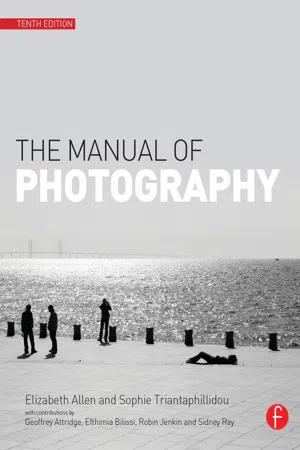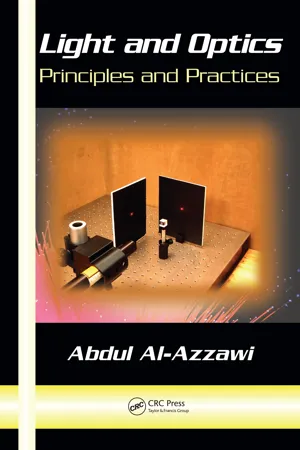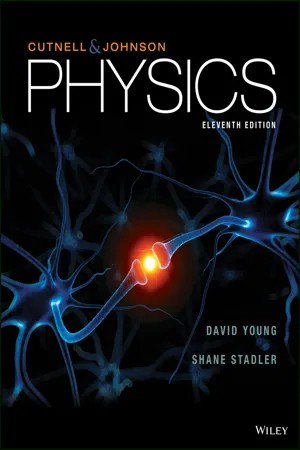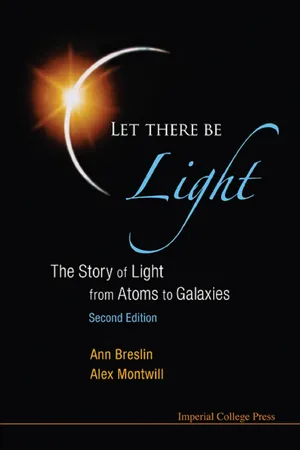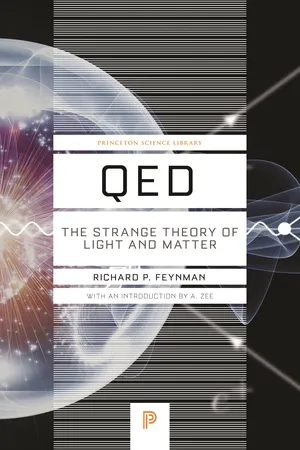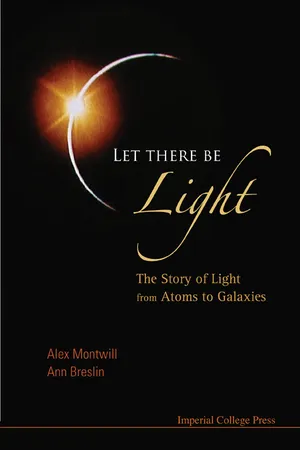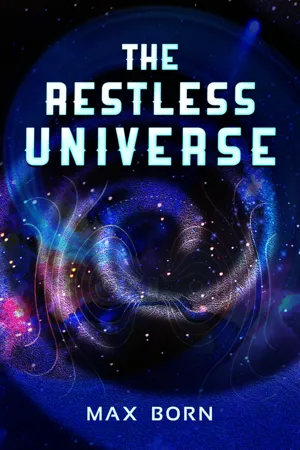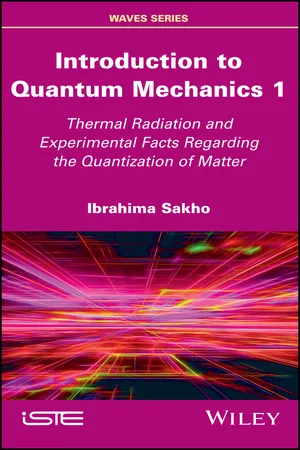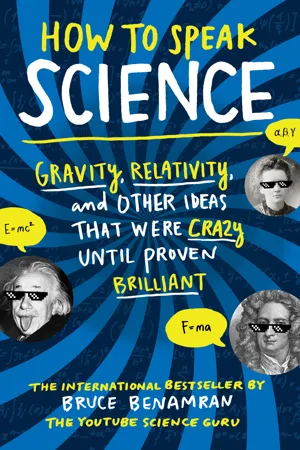Physics
Light Particles
Light particles, also known as photons, are the fundamental particles that make up light. They have properties of both particles and waves, and their behavior is described by quantum mechanics. Photons have no mass and travel at the speed of light, carrying energy and momentum. They play a crucial role in the field of quantum physics and are essential for understanding the nature of light.
Written by Perlego with AI-assistance
Related key terms
Related key terms
1 of 4
Related key terms
1 of 3
11 Key excerpts on "Light Particles"
- eBook - ePub
- Jeremy Sanderson(Author)
- 2019(Publication Date)
- Wiley(Publisher)
The higher the frequency of light, the greater the energy of the photon, as evidenced by the photoelectric effect. Thus a photon of blue light has almost twice the energy (see Box 2.1) of a photon of red light. Equally cautious, like Planck, about overturning received dogma of the wave nature of light, Einstein used the word ‘heuristic’ in the title of his paper, insisting that his radical idea was a helpful conceptual aid and shouldn’t be understood as a physical reality. Later experiments showed that these quanta of electromagnetic radiation possessed momentum, and could be considered as massless particles, ultimately to be named photons. Newton was (partially) back in vogue. Therefore, to the question ‘what is light’ only a partial answer can be given: it may be described in terms of photon ‘particles’ of energy quanta or as waves, according to the phenomena that need to be described (Table 2.1). We thus refer to the wave-particle duality of light. The wave picture of light corresponds to classical physics; the photon picture is quantum mechanical. These concepts are not contradictory but rather complementary: physics has yet to describe a fully unified model for electromagnetic radiation. Light, and its interaction with matter, is best considered in terms of photons. At the simplest level, the statistical behaviour of a large number of photons is represented by an electromagnetic wave. Heisenberg’s uncertainty principle limits our knowledge of quantum dynamic events, such as electromagnetic radiation. Thus light is not merely a smooth sine wave, but one whose amplitude and phase are ‘smudged’ by the travel of photon particles - eBook - ePub
- Elizabeth Allen, Sophie Triantaphillidou(Authors)
- 2012(Publication Date)
- Routledge(Publisher)
Photons differ from other elementary particles such as electrons in that they have zero mass or electric charge and consist purely of energy. When many photons are present, for example in a light beam, their numbers are so large that the inherent discontinuity or granularity of the light beam disappears and it appears as a continuous phenomenon. The photon can exhibit wave-like behaviour, resulting in phenomena such as refraction or diffraction, described earlier in this chapter. It also behaves as a particle when interacting with matter at a subatomic level, exchanging energy in discrete amounts. The amount of energy E (from Planck’s Law) exchanged during such an interaction is dependent on the frequency of light, and is known as the photon energy. This relationship may be rewritten in terms of the wavelength of the light: where c is the speed of light, h is Planck’s constant, v is the frequency and λ is the wavelength. This means that shorter wavelengths of light will have higher photon energy (see Figure 2.23, which shows the electromagnetic spectrum in terms of wavelength, frequency and photon energy). This becomes important later on, in understanding why imaging materials are sensitive to some wavelengths of light and not others (spectral sensitivity). BOHR MODEL OF THE ATOM In the early twentieth century, the commonly accepted model of the atom was the planetary model of Rutherford in 1911 (Figure 2.29), which consisted of a small densely packed positively charged nucleus, made up of protons and neutrons, about which clouds of negative electrons orbited, like planets around the sun. Rutherford’s model assumed that some outer electrons were loosely bound to the nucleus and could therefore be easily removed by applying energy. There is a problem with this model, however, as follows: the negative charge of the nucleus and the positive charge of the electrons mean that there is an electrostatic attraction between them - eBook - ePub
Light and Optics
Principles and Practices
- Abdul Al-Azzawi(Author)
- 2018(Publication Date)
- CRC Press(Publisher)
1 The Nature of Light 1.1 INTRODUCTIONThroughout history, humankind has been fascinated with the properties and behaviour of light. Light from the sun served as a catalyst in the formation of life on Earth. Solar and lunar light provided humanity with the celestial timepieces required to measure time.We live in a world bathed in light. Light is one of the most familiar things in our lives. We see things with eyes that sense the intensity (brightness) and wavelength (colour) of light. We experience light in a variety of other ways as well. For example, we sense radiant heat when our skin is near a warm object. This is due to our skin’s reaction to infrared radiation.We learn almost all of what we know about the world around us from the interaction of materials with electromagnetic waves. Often, the word light is used a little more broadly to include electromagnetic waves, such as in the ultraviolet and infrared waves that are just outside the visible range.Much of what we know about light has been discovered during the past five centuries. Initially, light was understood to be a particle. Light is now widely understood to be one part of a much larger electromagnetic spectrum. Photons, the smallest resolvable quanta of light, were initially described using particle theory; however, a wave model has since been widely adopted. In the context of the wave model, photons are energy packets moving through space and time.1.2 THE EVOLUTION OF LIGHT THEORYIn the 17th century, light was considered to be stream of particles that were emitted by a light source. These particles stimulate the sense of sight when entering the eye. The English physicist and mathematician Isaac Newton (1642–1727) was the inventor of the particle theory of light. Newton regarded rays of light as streams of very small particles emitted from a source of light and travelling in straight lines. Newton was able to provide a simple explanation for some known experimental facts concerning the nature of light, specifically, the laws of reflection and refraction. - eBook - ePub
- John D. Cutnell, Kenneth W. Johnson, David Young, Shane Stadler(Authors)
- 2018(Publication Date)
- Wiley(Publisher)
hf. Einstein made the proposal that light consists of such energy packets.29.3 Photons and the Photoelectric Effect
We have seen in Chapter 24 that light is an electromagnetic wave and that such waves are continuous patterns of electric and magnetic fields. It is not unexpected, then, that light beams, such as those in the photograph in Figure 29.3 , or those coming from flashlights, look like continuous beams. However, we must now discuss the surprising fact that visible light and all other types of electromagnetic waves are composed of discrete particle-like entities called photons . As discussed in Chapters 6 and 7 , the total energy E and the linear momentump →are fundamental concepts in physics that apply to moving particles such as electrons and protons. The total energy of a (nonrelativistic) particle is the sum of its kinetic energy (KE) and potential energy (PE), orE = KE + PE. The magnitude p of the particle's momentum is the product of its mass m and speed v, orp = mv. We will see that the ideas of energy and momentum also apply to photons. The defining equations for photon energy and photon momentum, however, are not the same as they are for particles such as electrons and protons.Although the spotlight beams in the photograph look like continuous beams of light, each is composed of discrete photons.FIGURE 29.3Experimental evidence that light consists of photons comes from a phenomenon called the photoelectric effect , in which electrons are emitted from a metal surface when light shines on it. Interactive Figure 29.4 illustrates the effect. The electrons are emitted if the light being used has a sufficiently high frequency. The ejected electrons move toward a positive electrode called the collector and cause a current to register on the ammeter. Because the electrons are ejected with the aid of light, they are called photoelectrons - eBook - ePub
From Atoms to Higgs Bosons
Voyages in Quasi-Spacetime
- Chary Rangacharyulu, Christopher J. A. Polachic, Chary Rangacharyulu, Christopher J. A. Polachic(Authors)
- 2019(Publication Date)
- Jenny Stanford Publishing(Publisher)
9 but in which no explanation is forthcoming for its emission and absorption in matter.The concept of the photon, as a discrete energy entity or packet of light, is not very different from that of Isaac Newton, who imagined light to be made up of corpuscular bullets. But in classical Newtonian thinking, there was no association between the frequency of light and its energy. In the quantum concept, this is a chief characteristic of light: the energy of a photon isE = h v (9.2)as originally given by Planck, where h is a constant of Nature. The frequency parameter for light (v ) is a continuous variable, and so is the energy that a photon may have.9.3 Waves and Particles, Real and Virtual
Until very recently, photons occupied a unique status in particle physics. A “free” photon has zero mass, which makes the energy and momentum numerically the same value. We would recognize this as a kinetic momentum . Another kind of momentum, the canonical momentum , is defined for a photon that is not free, but present within a material medium. As photons propagate in media, they may exert a push or pull on the material, which can be modeled as an effective mass for the photon. In this context, the canonical momentum is sensitive to the electromagnetic properties of the medium in which the photon is moving.Maxwell’s theory of electromagnetism, combined with the spacetime concepts of Einstein’s relativity as a basic premise, yields a body of theory called electrodynamics . Early developments in quantum theory incorporated photons as waves, with quantum mechanical representations for the material bodies with which photons might interact. Photon-matter scattering was described very well by the Klein–Nishina formula , which treats photons as monochromatic waves of well-defined energy. Following the development of quantum electrodynamics (QED), theorists checked that new theory to see if it agreed with the successful Klein–Nishina formula, although the concept of radiation is ontologically very different in the two frameworks. In QED, matter particles and photons do not move in space. Rather, when a photon’s position changes from point A to point B, we mathematically destroy one photon at point A and create another at point B.10 This QED process does not obey the principle of causality and leaves the physical system in an energetically unphysical state for a short time interval—an acceptable situation if we invoke Heisenberg’s uncertainty relations. An example of this kind of scenario is the well-known Compton scattering - eBook - ePub
Let There Be Light
The Story of Light from Atoms to Galaxies
- Ann Breslin, Alex Montwill(Authors)
- 2013(Publication Date)
- ICP(Publisher)
Chapter 13Atoms of Light Acting as ParticlesThe energy of light comes in quantum units of value hf. In this chapter we go a step further, and look at evidence that it comes as a bundle, concentrated at a point, and behaves just like a particle. We will describe experiments that show that the photon has not only energy but also momentum.First, we will show that the photon can behave like a bullet, causing considerable disruption to the surfaces of materials, particularly metals, whose atoms have loosely-held outer electrons which are vulnerable to such bombardment. In the photoelectric effect an electron is knocked out from the surface of a metal by a photon. Because this happens instantaneously, and from the energy of the ejected electron, we can deduce that the collision is a ‘one-on-one’ encounter. There are many practical applications; we can use the photoelectric effect whenever we want to translate a light signal into an electric current.Next, we will look at an experiment which demonstrates that the photon has another characteristic of a particle, namely momentum. In the Compton effect the photon bounces off an electron, and the two then go off at different angles. We can apply the laws of conservation of energy and momentum to calculate angles and energies, just as we do for a collision on a snooker table.There is one interesting difference between a scattered photon and a scattered snooker ball. The photon cannot slow down; it always travels at the speed of light. As it loses energy and momentum, its frequency decreases and its wavelength increases accordingly, so its speed remains constant.13.1 The photoelectric effect Evidence for the particle nature of lightAs the new ideas presented by Planck were being discussed, Albert Einstein turned his attention to the specific nature of the quantum of light. As he pointed out, Maxwell’s classical theory had been truly tried and tested with respect to the propagation - eBook - ePub
Princeton Science Library
The Strange Theory of Light and Matter
- Richard P. Feynman(Author)
- 2014(Publication Date)
- Princeton University Press(Publisher)
2
Photons: Particles of Light
This is the second in a series of lectures about quantum electrodynamics, and since it’s clear that none of you were here last time (because I told everyone that they weren’t going to understand anything), I’ll briefly summarize the first lecture.We were talking about light. The first important feature about light is that it appears to be particles: when very weak monochromatic light (light of one color) hits a detector, the detector makes equally loud clicks less and less often as the light gets dimmer.The other important feature about light discussed in the first lecture is partial reflection of monochromatic light. An average of 4% of the photons hitting a single surface of glass is reflected. This is already a deep mystery, since it is impossible to predict which photons will bounce back and which will go through. With a second surface, the results are strange: instead of the expected reflection of 8% by the two surfaces, the partial reflection can be amplified as high as 16% or turned off, depending on the thickness of the glass.This strange phenomenon of partial reflection by two surfaces can be explained for intense light by a theory of waves, but the wave theory cannot explain how the detector makes equally loud clicks as the light gets dimmer. Quantum electrodynamics “resolves” this wave-particle duality by saying that light is made of particles (as Newton originally thought), but the price of this great advancement of science is a retreat by physics to the position of being able to calculate only the probability that a photon will hit a detector, without offering a good model of how it actually happens.In the first lecture I described how physicists calculate the probability that a particular event will happen. They draw some arrows on a piece of paper according to some rules, which go as follows: - eBook - ePub
Let There Be Light
The Story of Light from Atoms to Galaxies
- Alex Montwill, Ann Breslin(Authors)
- 2008(Publication Date)
- ICP(Publisher)
Chapter 13Atoms of Light Acting as Particles
The energy of light comes in quantum units of value hf. In this chapter we go a step further, and look at evidence that it comes as a bundle, concentrated at a point, and behaves just like a particle. We will describe experiments that show that the photon has not only energy but also momentum.First, we will show that the photon can behave like a bullet causing considerable disruption to surfaces of materials, particularly metals, whose atoms have ‘loose’ outer orbit electrons which are vulnerable to such bombardment. In the photoelectric effect an electron is knocked out from the surface of a metal by a photon. Because this happens instantaneously, and from the energy of the ejected electron, we can deduce that the collision is a ‘one-on-one’ encounter. There are many practical applications; we can use the photoelectric effect, whenever we want to translate a light signal into an electric current.Next, we will look at an experiment which demonstrates that the photon has another characteristic of a particle, namely momentum. In the Compton effect the photon bounces off an electron, and the two then go off at different angles. We can apply the laws of conservation of energy and momentum to calculate angles and energies just as we do for a collision on a snooker table. In this experiment we look at the photon after it has been scattered in the collision.There is one interesting difference between a scattered photon and a scattered snooker ball. The photon cannot slow down; and always travels at the speed of light. It loses energy and momentum by decreasing its frequency and correspondingly increasing its wavelength, without changing its speed. The exact way in which this should happen is calculated in Appendix 13.1 - eBook - ePub
- Max Born(Author)
- 2013(Publication Date)
- Dover Publications(Publisher)
CHAPTER III Waves and Particles1. Light-waves and Interference.L IGHT is the most important messenger bringing us news from the outside world. What does it really tell us? We think we actually see things, their outlines and colours. In reality the light merely reports this: “I come from such and such a direction, vibrate with such and such an intensity and such and such a frequency, and I have entirely forgotten what happened to me on the journey on which I set out just after my birth and which ends here on your retina with my death.” Everything else, such as our perception of coloured objects, is not like a newspaper reporter’s “copy”, but is an unconscious combination by the editorial department (the brain) of thousands and thousands of these reporter’s messages, depending on impressions derived from all the senses taken together.Most people find this journalistic combination so fascinating that they scarcely pay any attention to the reporter’s skill. The physicist, however, finds these very reports particularly attractive. He does not combine them unconsciously, but, on the contrary, deliberately sets out to analyse them, using considerable ingenuity and cunningly devised apparatus. Then they tell him quite a different story, one of a restless universe of atoms, governed by strange laws.Light itself forms part of the restlessness in the world of the very small. Even where there are no atoms, in empty interstellar space, for example, there are light-rays coming from the stars and moving in all directions. And near the stars, which of course are glowing suns, like our sun, light vies with the atoms, rushing on in a wild dance.As we have already said, it is usual to regard light as a wave motion, each wave-length corresponding to a definite colour. At the time of the great Newton, this idea was not accepted without contradiction. Newton himself preferred the hypothesis that light is a rain of particles (“corpuscles”) given out by the body emitting the light. He could not understand how the wave theory, which had by then been devised by Huyghens, could explain the propagation of light-rays in straight lines (i.e. the fact that shadows have sharp boundaries), which is immediately obvious on the basis of the corpuscular theory. Newton made great discoveries in optics: in particular, he succeeded in splitting up white sunlight into the colours of the rainbow by means of a prism; as we should say to-day, he produced its spectrum. - eBook - ePub
Introduction to Quantum Mechanics 1
Thermal Radiation and Experimental Facts of the Quantization of Matter
- Ibrahima Sakho(Author)
- 2019(Publication Date)
- Wiley-ISTE(Publisher)
2 Wave and Particle Aspects of Light General objective Gain knowledge on the wave and particle properties of light. Specific objectives On completing this chapter, the reader should be able to:- – define coherent sources;
- – describe Young’s experimental set-up;
- – define the interference field;
- – provide an interpretation of how interference fringes form;
- – define the path difference;
- – define the order of interference;
- – determine the spacing between fringes;
- – describe the experimental set-up for observing the photoelectric effect;
- – define the photoelectric effect;
- – provide an interpretation of the photoelectric effect;
- – use Einstein relation;
- – define the photoelectric threshold;
- – express the stopping potential;
- – define the saturation current;
- – determine the quantum efficiency of a photoelectric cell;
- – define the sensitivity of a photoelectric cell;
- – experimentally determine Planck constant;
- – describe the experimental set-up for observing the Compton effect;
- – define the Compton effect;
- – provide an interpretation of the Compton effect;
- – define the Compton wavelength of the electron;
- – establish the Compton shift in wavelength;
- – express Planck–Einstein relations combining the wave and particle properties of light.
- – plane electromagnetic wave;
- – light diffraction;
- – photon characteristics;
- – energy and linear momentum of a relativistic particle.
2.1. Light interferences
2.1.1. Elongation of a light waveLight propagates in an arbitrary medium through vibrations of plane electromagnetic waves [STA 08, SAK 18]. These are transverse waves since the electric and magnetic fields are perpendicular to one another and to the propagation direction, which is given by the direction of the wave vector . Let us consider a light wave that propagates along Ox and whose period is T. The elongation of the wave - eBook - ePub
How to Speak Science
Gravity, Relativity, and Other Ideas That Were Crazy Until Proven Brilliant
- Bruce Benamran(Author)
- 2018(Publication Date)
- The Experiment(Publisher)
Despite the doubts and slow acceptance of the theory, Einstein won the Nobel Prize in 1921 “for his services to Theoretical Physics, and especially for his discovery of the law of the photoelectric effect” based on that first article. Even so, the scientific community didn’t rally around Einstein until Arthur Holly Compton’s X-ray diffusion experiments in 1923. After that, light was no longer considered to be a wave but a particle, a photon.However, electromagnetism considered light as a wave phenomenon, and the theory worked very well—much better than particle theories. In fact, it looked like wave and particle theory took turns at being the most suitable model, depending on the phenomenon studied. This issue would give rise to a whole new field of physics: quantum physics .The PhotonThe photon is a particle of light—as much as it can be a particle. It’s a particularly peculiar particle because along with its ability to act like a particle or a wave, it is electrically neutral and has no mass and no size—so much for being a particle. It moves at the speed of light, obviously; it is part of light. Now this is important: a photon can move at only the speed of light. It doesn’t slow down; it doesn’t speed up; and it never stops.11. Why Do They Turn Off Airplane Cabin Lights for Night Landings?
As you may already know, when planes land at night, aircraft passenger cabin lights are turned off ten or fifteen minutes before landing. Why do they do that? Ask the people around you and you get all kinds of responses! Here are a few particularly good ones: the person to your left might say it’s to save energy in case they have to go around again before landing. This one screams—violently—for correction: First of all, can anybody really believe that the energy needed for landing could possibly be affected by a few little lightbulbs? Moreover, why don’t they turn out the lights when landing during the day? Because of solar panels? The person on your right might say: It’s so the pilot can see the landing strip more clearly. You know, like in a car at night. You don’t turn on a dome light while driving, because light reflects off the windshield and reduces the driver’s field of vision—yeah . . . uh, no. First of all, the pilot is in the cockpit, which is darkened for the entire duration of the flight for the exact reason of eliminating the light pollution issue—the passenger cabin is completely isolated from the cockpit by a solid door. On the passenger side of the door, Skrillex and Lady Gaga could put on the most spectacular sound and light show ever, and it wouldn’t make any difference at all to the pilot. The person behind you leans forward and chimes in: Maybe it’s because they want the passengers to be able to enjoy the panoramic view of the city lights at night? Nope. And last but not least—this is my favorite—someone turns around and says: It makes the plane more visible to the control tower. When I hear this reply, I sense this person’s intense desire to give an answer—any answer, no matter how ridiculous—just to give some kind of answer. First of all, air traffic controllers in the control tower are looking at screens, not the aircraft. Furthermore, illuminating the interior lights would make the aircraft more visible in the dark. This last idea is quite simply nonsense—it’s not a big deal, but you should know—no scientists worthy of the name would offer that response. The real reason they turn out the lights in an aircraft before a night landing is . . . drumroll please . . . for safety reasons
Index pages curate the most relevant extracts from our library of academic textbooks. They’ve been created using an in-house natural language model (NLM), each adding context and meaning to key research topics.
Explore more topic indexes
Explore more topic indexes
1 of 6
Explore more topic indexes
1 of 4

